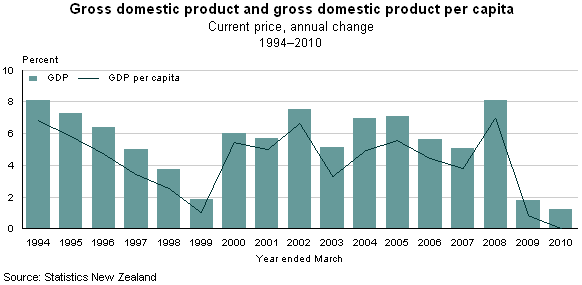Household spending slows

Household spending rose 2.0 percent in the March 2010 year, the lowest percentage increase since the year ended March 1993 (up 1.8 percent), Statistics New Zealand said today. "The slow rise in household spending compares with increases of at least 4 percent between 1994 and 2008," acting national accounts manager Jason Attewell said.
Spending on all transport sub-categories was down in the year ended March 2010, with the largest decline being in vehicle operations such as repairs and maintenance. A fall in spending on furniture and major appliances was also recorded, driven by a fall in prices.
Gross domestic product (GDP) in current prices increased 1.2 percent for the year ended March 2010. This is the smallest increase since the year ended March 1992 and follows a 1.8 percent increase in the March 2009 year.
Contributing to the low increase in GDP in the March 2010 year were:
- compensation of employees rising 1.1 percent, compared with the previous year's increase of 5.7 percent
- gross operating surplus (business profits) increasing 0.4 percent for the year ended March 2010.
National disposable income, which can be used for consumption or saving, rose 4.3 percent for the year ended March 2010. Contributing to this was a decrease in net investment income paid to the rest of the world, down from $13.0 billion in 2009 to $7.6 billion in the year ended March 2010.
National saving (for the whole economy) was $3.2 billion in the year ended March 2010. This compares with near zero saving for the year ended March 2009. Higher national saving was a result of the increase in national disposable income and the slowing of household spending.
Highlights
- Current price gross domestic product (GDP) rose 1.2 percent, while GDP per capita was unchanged.
- National disposable income rose 4.3 percent, driven by net investment income from the rest of the world.
- Investment in fixed assets fell 8.6 percent, due mainly to a 16.9 percent decrease in investment in plant, machinery, and equipment.
- Final consumption expenditure rose 2.2 percent, with household spending up 2.0 percent. Central and local government expenditure rose 2.3 percent and 4.2 percent, respectively.
- Net borrowing from overseas fell from $14.3 billion in the March 2009 year to $4.8 billion in the March 2010 year.
- National saving (for the whole economy) was $3.2 billion.
